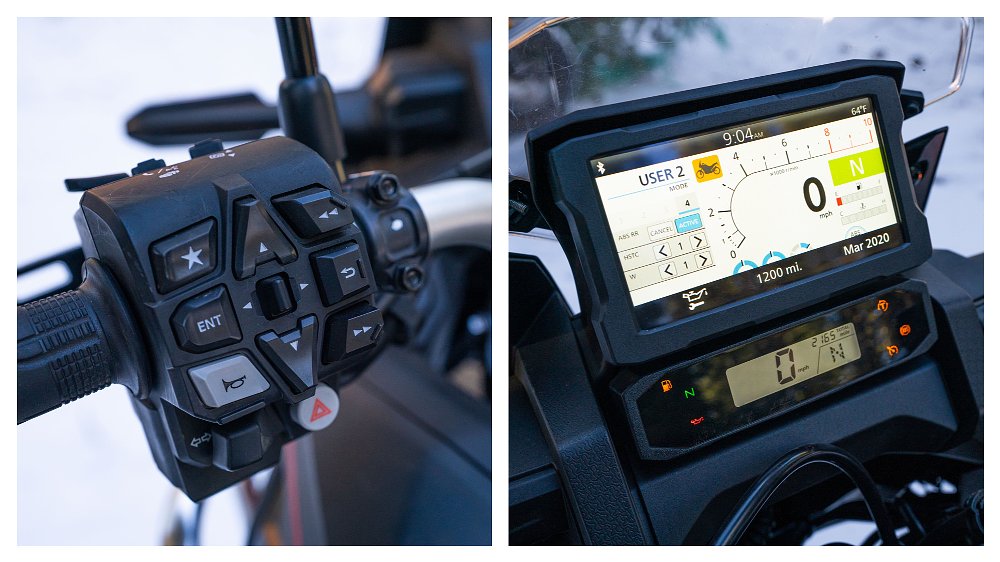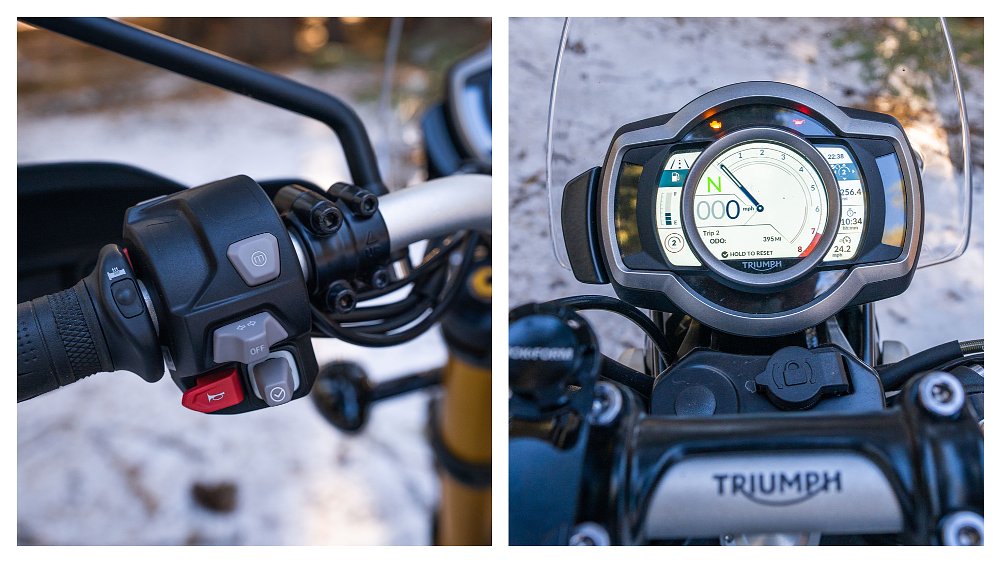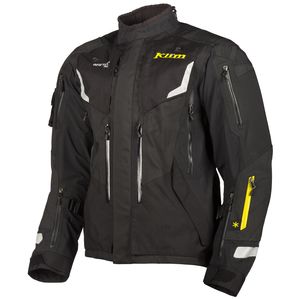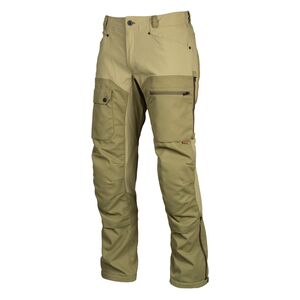Cutting down a Christmas tree wasn’t a holiday tradition in my household growing up, but watching "National Lampoon’s Christmas Vacation" was.
And in that classic Chevy Chase comedy, the Griswold family drives out into the woods to select the perfect tree, saw it down, and haul it home. Well, that’s exactly what Zack and I (and director extraordinaire Spenser Robert) decided to do, except instead of piling into a 1979 Ford LTD Country Squire and heading to Breckenridge, Colorado, like the Griswolds, we set out in Truckee, California, on a Honda Africa Twin 1100 and a Triumph Scrambler XE, both 2020 models.
It’s a silly comparison, sure, but we’d been tasked with making a holiday-themed episode of CTXP, which you can watch below. And as it turns out, in the course of wrangling the Honda and Triumph through the woods, we ended up testing them pretty thoroughly.
Let’s meet our lumberjacks
These bikes may seem mismatched, but take a look at their specs. Lemmy said it first: The Scrambler XE is essentially a full-bore adventure bike, it’s just dressed in waxed cotton and oiled leather instead of the status quo military fatigues.
Both Triumph’s retro-cool Scrambler XE and Honda’s archetypal ADV have burly parallel-twin engines, nearly 10 inches of suspension travel, large spoked wheels (to which we added Bridgestone Battlax Adventurecross AX41 knobbies), dirt-specific TC and ABS modes, and other off-road attributes that make them appropriate for tree retrieval, or at least getting into the woods where the good trees grow. Shoot, they even have nearly identical 500ish-pound weights, 62-inch wheelbases, 34ish-inch seat heights, and prices ($14,400 for the AT, $15,400 for the XE), not to mention TFT dashes, cruise control, LED lighting, and other features.
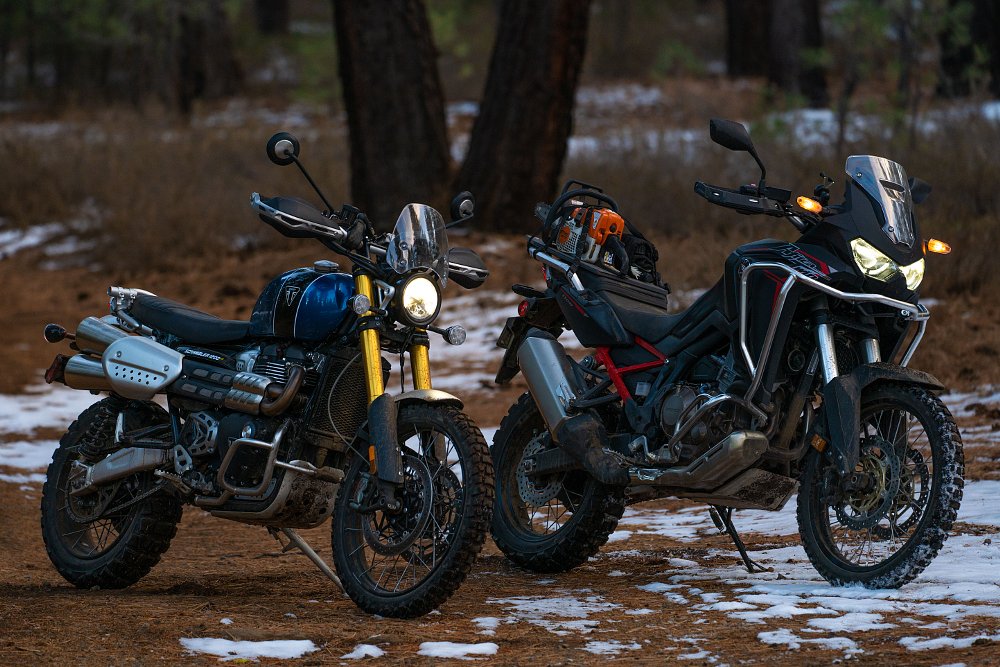
The biggest distinction, then, other than the chainsaw we lashed to the back of the Africa Twin, seemed to be stylistic. So with the chance to ride the bikes back to back on a tree-cutting adventure, we were eager to determine if the machines’ differences were more than just skin deep.
On the road
Speaking of skin, ours revealed the biggest and perhaps most predictable disparity in terms of riding experience: wind protection. As we set out into the 20-degree air of a Sierra Nevada morning, Zack was almost entirely unprotected on the Triumph, though he alleged that his trendy accessory windscreen did keep the wind off his belly button. I had my doubts, but knew for certain that his hands were warm, thanks to the XE’s stock heated grips.
You’ll have to drop $170 for the accessory heated grips for the Honda, but its short rally-style windscreen, wide tank, and hand guards meant I was far better shielded from the cold as we rode into the mountains toward the trail head. For traveling in crummy weather or spending any amount of time at speed, the Honda’s marginal bodywork makes it a winner, at least compared to a completely naked scrambler.
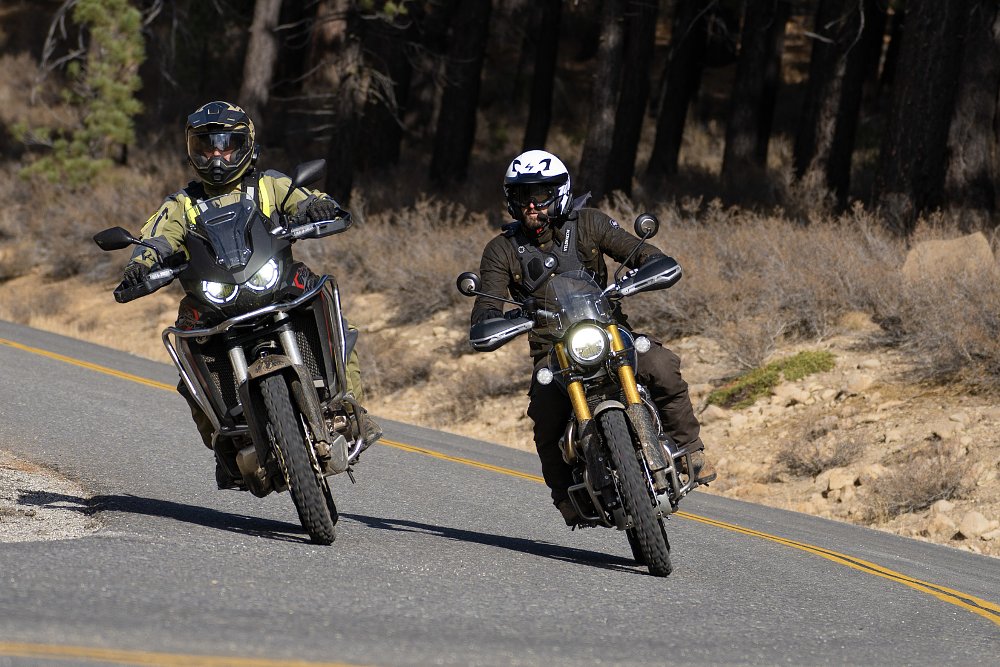
Wind protection aside, either bike is a comfortable and capable way to reel in miles of straight or twisty pavement. The Africa Twin is a proven mile-eater, with an easygoing engine that now cranks out a touch more power by way of 6.4 mm extra stroke. The riding position is relaxed, and despite a handlebar that’s higher by nearly an inch compared to the 2019 model, the grips feel like they’re in your lap. Perhaps it’s the bend in the new aluminum bar, or maybe we just needed to rotate it forward a bit.
Triumph’s handsome Scrambler XE has a similarly calm-yet-potent engine character, and other than a raspier exhaust note you’d be hard pressed to tell the motors apart. The rider triangle is noticeably different, with a handlebar that’s higher and farther forward, a little less legroom, and header pipes that crowd your right knee and kick off an amount of heat that’s irritating in sub-freezing temps so liable to be pretty painful come summer. The flat seat that’s so period correct and, well, flat, is actually quite comfy, and never wore on us the way we expected it to.
You feel like you’re sitting on the Triumph rather than in the Honda, and despite similar weights — 517.5 pounds for the Honda, 512 pounds for the Triumph, as tested with crash bars and a few other accessories — the Scrambler seems quite a bit lighter, likely because it’s so much more compact. We’ve all heard how important mass centralization is, right?
We continued into the hills on a pleasantly twisty stretch of asphalt, dodging the muted gloss of ice patches that lingered in the shade of the pines, firs, and hemlocks that lined the road. Even on knobbies, both bikes are sportier than they look, with light and sure-footed steering, though the taller Honda is more eager to bend down toward an apex. Despite having nearly an inch more suspension travel, Triumph’s Scrambler XE (the “E” stands for Extreme) has a firmer ride on account of stiffer springs and significantly more aggressive damping schedules. The Africa Twin is several grades softer, so has a more plush ride, but it readily moves through its suspension stroke if you stab the brakes or apply a handful of throttle.
Into the woods
It was midday, and we were finally ready to venture into the woods and start hunting trees. Before we hit the dirt, though, we pulled over to switch to the appropriate off-road ride modes. Both bikes have them, but the Triumph’s are far easier to access and select. Despite the abundance of new buttons inboard the Africa Twin’s left grip (and a touchscreen TFT dash), moving through the menus is no easy task. But with TC turned down and ABS on the front wheels only, we set out along a few miles of graded forest road that would lead us to a tangle of single-track where we’d been told the most attractive trees grew.
Snow, as everyone knows, is slippery, and you don’t get much leeway on a 500-pound bike. The TC helped keep wheelspin in check, but even flat sections of dirt were a skate fest, and mild inclines felt like Erzberg. Need to turn? I hope you have flat-track experience. Zack and I had been chatting steadily on the way in, but during the first few miles of snowy riding the only sounds coming over the headsets were grunts, whimpers, and expletives as we fought (and occasionally failed) to stay upright.
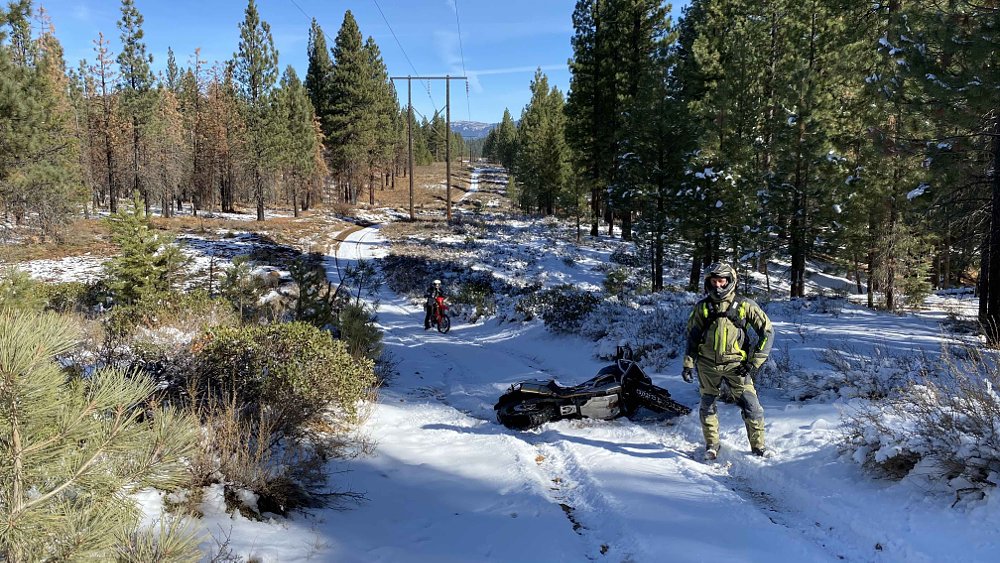
Mercifully, we got the hang of things, but the struggle made us especially excited to put the hammer down on exposed dirt. The few rain bars and berms we were able to hit at speed exaggerated the suspension differences we’d felt on the street. The Africa Twin sometimes bottomed the fork, while the Triumph soaked up hits like a trophy truck. Zack even took some compression out of the XE’s suspenders to soften it up, while I was inclined to crank in more of everything on the Honda. My fingers were too cold to handle tools, so I opted to slow down instead. That is, until Zack and I decided to race.
Curious to compare the refinement of the bikes’ electronic aids, we devised a challenge at the foot of a long slope blanketed in a few inches of snow: Click over to the most lenient TC settings, hold the throttle wide open so the computer has to do all the work, and see who gets to the top of the hill first.
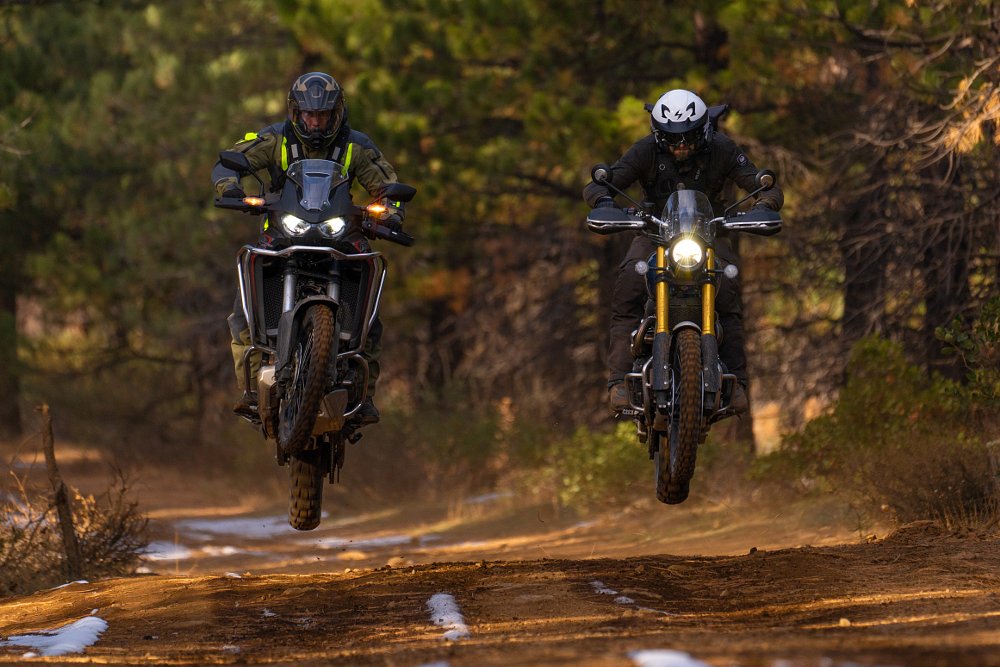
We counted down from three and then let out the clutch levers, opened the throttles, and sent the engines revving and the rear tires spinning — a lot more than we expected! It took nerve to hold the throttles open as the big twins strained against the TC, but it was even harder to keep the motorcycles on course as they charged up the hill with far more drive than anticipated.
It wasn’t graceful, but the Africa Twin made it to the top first, not because its 100 horsepower is slightly higher than the Triumph’s 90, but because its more adjustable and indulgent electronics let it put more of that power down. Perhaps those complicated, counterintuitive menus are worth it after all.
The final climb
At the edge of a massive stand of Jeffrey pines, obscured beneath several inches of untrodden snow, was our single-track trailhead. Everything we’d ridden so far was accessible by car or truck, and we hoped the remoteness this trail afforded would mean primo, motorcycle-size trees. We’d seen some attractive options so far — as well as plenty of clean-cut stumps — but nothing that stopped us in our tracks. Like Clark Griswold, we were committed to finding the ideal trees to adorn our living rooms.
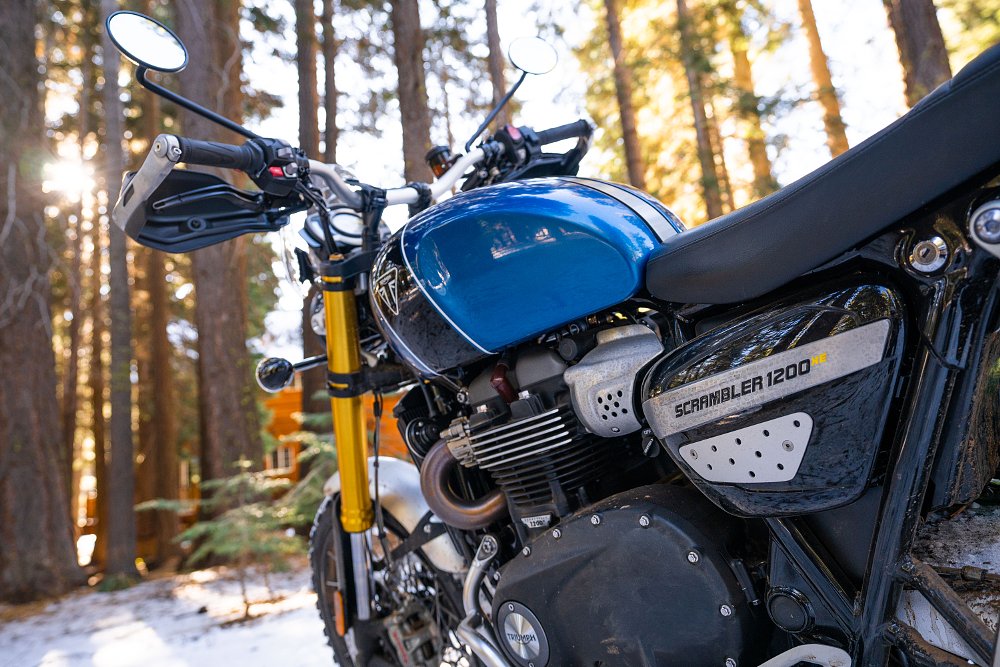
We set in on what the map suggested was a several-mile climb to the top of a knoll. Although the Honda won the hill climb, every rock garden and root snarl, every rut and berm, exposed a gap in the bike’s capabilities. Other than a lack of steering lock that made switchbacks tricky, the Scrambler XE was proving to be every bit as intrepid as the Africa Twin 1100, if not more so. Better suspension, more ground clearance, and a more manageable size meant that Zack skipped ahead up the narrow trail, with a calmer tone to his voice and more laughter coming over the headset.
Meanwhile, my teeth were clenched as I struggled to keep the Africa Twin upright. I wasn’t always successful. My 32-inch inseam was partially to blame, but so was the Africa Twin’s top-heavy nature. And its fairing. While it kept me warmer on the road, the bodywork obscured my view of rocks and roots on the trail, so I kept glancing off obstacles and losing my balance.
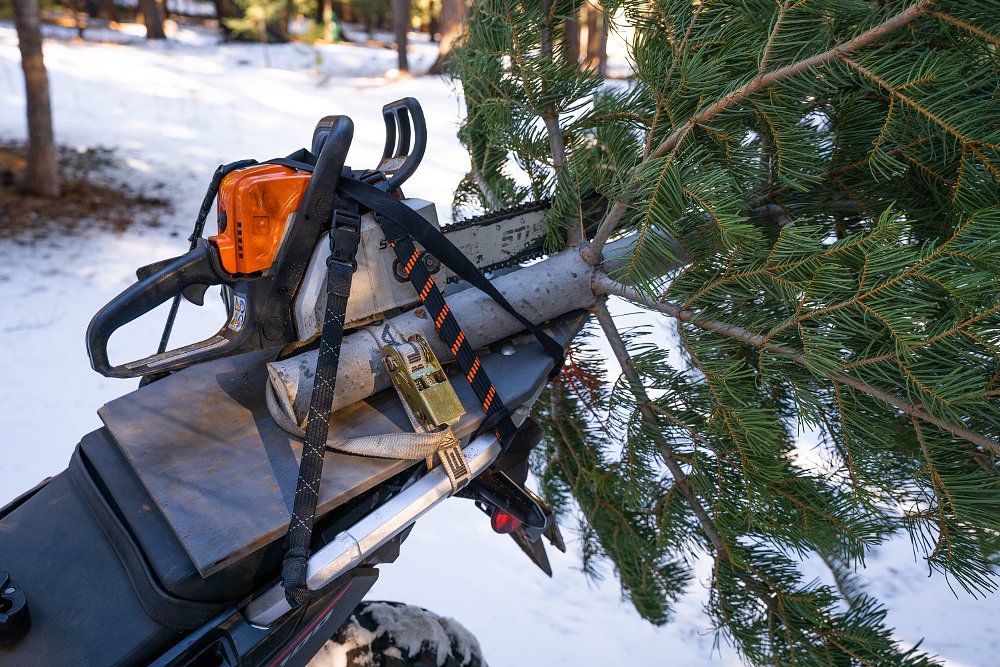
Deadlifting a quarter ton isn’t fun. Neither is repeatedly diving into the menus to turn off the ABS and TC, which resets every time the ignition is turned off (and you have to cycle the key to reactivate the fuel pump after you tip over). It’s an annoying function, but the solution seems clear: fall over less. A taller, stronger, more skilled rider probably wouldn't have been so frustrated.
Even with their challenges, both bikes got us to the top of the hill. Just in time, too, because the sun was getting perilously close to the horizon and we could feel the temperature plummeting.
As promised, the tree options were abundant. Symmetrical monoliths of young conifers poked up from the waist-high shrubs all around us, so we grabbed our saws and dashed off to complete our mission.
“Looks great. Little full… a lotta sap.”
I felled an eight-footer with the Stihl MS170, and Zack returned with a truly massive tree that he dropped with his retro-appropriate bow saw. Like ‘ol Sparky Griswold, we went a little big with our tree selections, something we only fully recognized once it was time to lash them to the bikes.
Luckily, the Honda’s grab handle was a solid platform to ratchet-strap my tree to. It’s also an ideal foundation for a variety of factory and aftermarket racks, panniers, top boxes, backrests, and other luggage and comfort accessories. The Triumph’s high pipes don’t leave much room for luggage, so riders will need to get creative with their cargo, as Zack did with a surfboard rack.
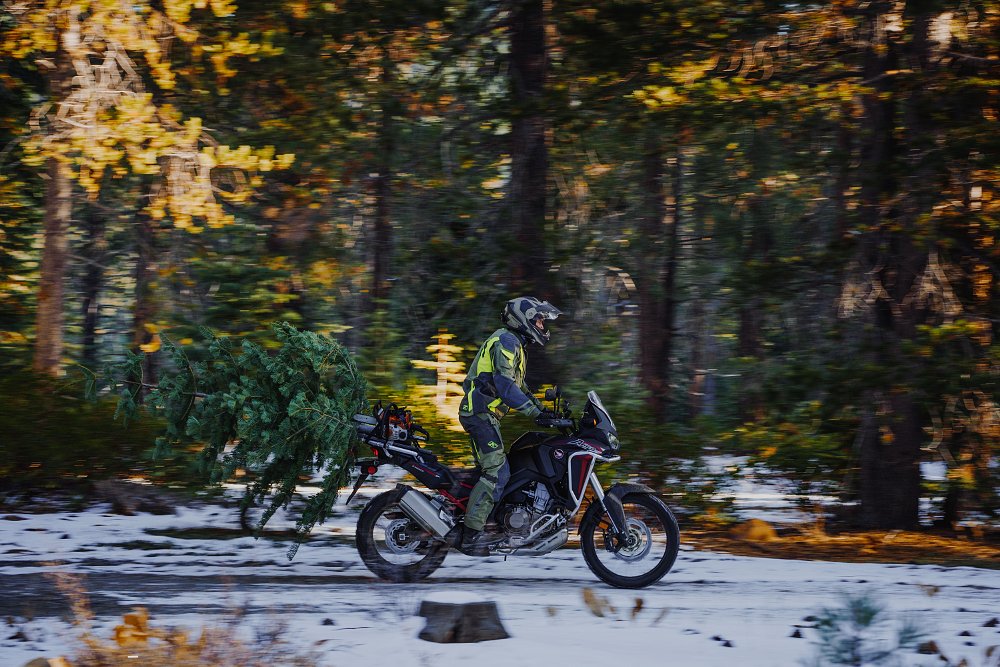
My setup made for a bizarre tail on the AT, while Zack’s arrangement placed his tree perilously close to the ground, but we were loaded up and ready to go. All that was left between us and the warmth of our AirBnB was several miles of single-track and a few miles of road, which we now had to navigate in the dark.
“Hallelujah! Holy sh*@t. Where’s the Tylenol?”
Suffice to say we made it off the mountain alive, but it was a tough, slow, cold ride. The following morning, after eating a few Advil, we wandered outside to assess our trees. Zack’s was a bit worse for wear after getting more or less dragged down the hill, whereas my tree didn’t have a needle out of place. Chalk that up as a win for the Africa Twin.
Honda’s adventure bike has broader capabilities and its design makes it better for hauling trees out of the forest or toting your gear across the continent. It’s a calm and comfy motorcycle that will happily fill in as your daily commuter, touring rig, or casual fire-road explorer. It’s a great bike, though its most recent update has made it complicated in a way that detracts from the simplicity we’ve always appreciated about the Honda.
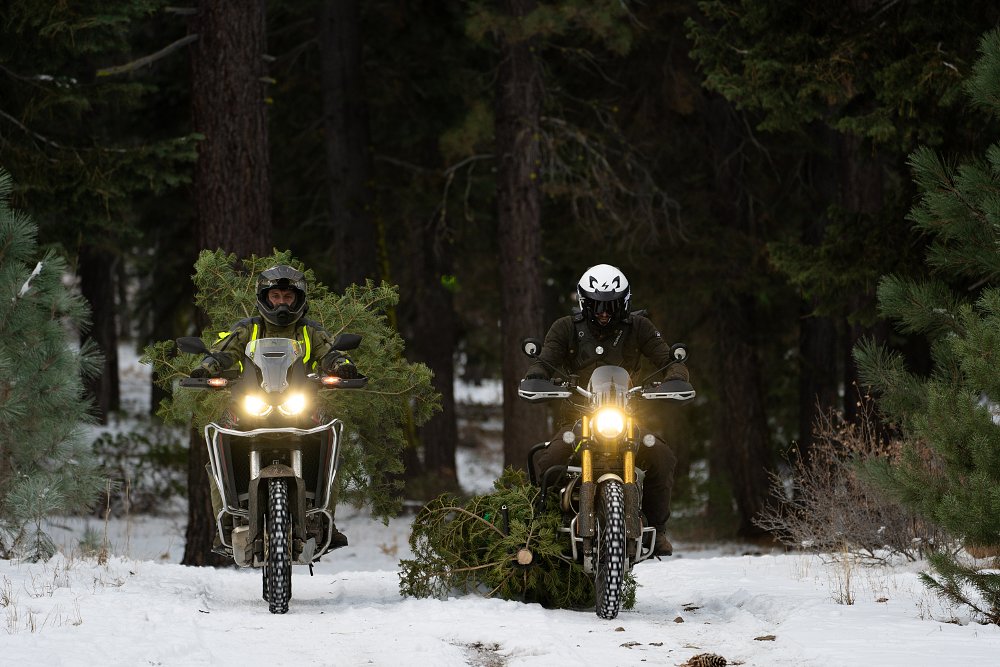
Ultimately though, we were both enamored with Triumph’s Scrambler XE. Sure enough, it’s a bona fide ADV that works even better than it looks, and damn it looks good. And that’s what we were out to determine, right?
The Scrambler XE’s lack of steering sweep is an unfortunate limitation, given how capable the rest of the package is, but it’s honestly a hoot to ride. Better handling and balance make you more inclined to seek out roots and rocks to pop over, and it’s got enough grunt to wheelie over stuff. For a stylish bike around town and a willing single-track slayer, it’s tough to beat.
As for family traditions, I’m not sure this motorcycle tree retrieval thing is going to stick. Wrestling a Christmas tree out of the woods can wear on you, whereas watching Clark Griswold do it never gets old.

 Membership
Membership


